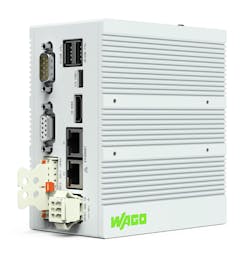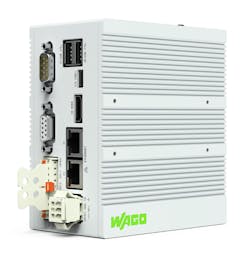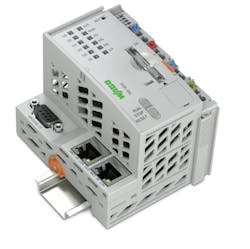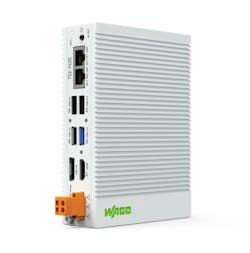As more end users attempt to adopt cloud and edge technology to maximize efficiency, increase productivity, and share data seamlessly, some key factors need to be taken into account.
One of the biggest challenges in moving data from the plant floor to the cloud can be legacy systems. There may not be a clear-cut way to get data from a serial-based communication system to an Ethernet-based cloud platform. Legacy systems can make the users feel that their data is confined to the plant floor, which can significantly impede automation and operational effectiveness. Even with the implementation of an Ethernet-based control system, the solutions for getting this information to the cloud is not always simple.
Easy solutions for bridging the gap between legacy devices and IIoT are gateways. These systems can bring in legacy data via serial or Ethernet communications and then pass this data onto cloud platforms or edge devices. One solution for this is the Wago PFC 200 controller which has two Ethernet ports (switched or independent) with serial 232/485 (Modbus), CANopen (J1939) and Profibus interfaces. This allows the user to move data from one communication platform to another. The Touch Panel 600 is another product that utilizes two Ethernet ports (switched or independent) with serial 232/485(Modbus) and CANopen (J1939).
Network security
When two worlds collide, things can get messy. This can be the case when bringing operational technology (OT) and information technology (IT) together. Typically, one of the first conflicts here is network security. Particularly regarding authentication, authorization, accounting, encryption, secured connections, data integrity, and confidentiality. Many Ethernet-based industrial systems today can help smooth things over with the IT group.
There are controllers and PLCs that have built-in security measures such as firewalls, VPN connectivity, port controls/filtering, and password authentication. Another layer of network security is industrial managed Ethernet switches. These provide security features such as MAC security, radius authentication, traffic/bandwidth controls and VLAN capabilities.
An IIoT-connected factory has the potential to make production better, facilities more energy efficient, and improve predictive maintenance and asset tracking. Managers can monitor manufacturing at each facility workstation. Device and plant floor operators can track products throughout the supply chain and alert participants of damage to goods. Real-time data from IIoT-connected systems can help predict failures on the plant floor before they happen. With all of these users, trying to manage a solution for the data collection and distribution can be a challenge.
There are many choices for data formats, but the key is identifying the data needs for your operations. A good place to start is analyzing your system’s requirements based on component services and database needs.
Which platform for sharing data
There are several IoT cloud platforms from different service providers that host wide-ranging applications for data analytics and management. IIoT cloud platforms such as Microsoft Azure, Amazon AWS, IBM Bluemix, or Wago Cloud have features that include connectivity and network management, device management, data acquisition, processing analysis and visualization, application enablement, integration, and storage. The goal for IIoT cloud platforms is to maximize the analytics and data processing between the cloud and device, incorporating resources at each end seamlessly. The right solution really depends on the users’ requirements and its fit into the application.
In the cloud, all data is gathered and processed in centralized data centers. As such, it serves as a general-purpose platform for data collection, analytics, and historical reporting. Edge computing devices can collect and process data at the machine level allowing for faster and more effective responses. It is more about real time changes to achieve more accurate, efficient production runs and predictive maintenance events. Another benefit of edge computing is machine learning, which enables systems to automatically learn and improve tasks without making program changes.
Wago has recently added an edge controller and edge computer to its product line. The controller offers one CANopen port, two Ethernet ports, a serial RS-232/485 port and two USB ports. It also has four digital inputs/outputs for connecting local devices or sensors. The computer features a 1.91 GHz quad-core Atom processor, two Ethernet ports, four USB ports, and is equipped with Debian Linux for Docker-based applications. With these edge devices, users can achieve a seamless bridge between OT and IT data connectivity.




